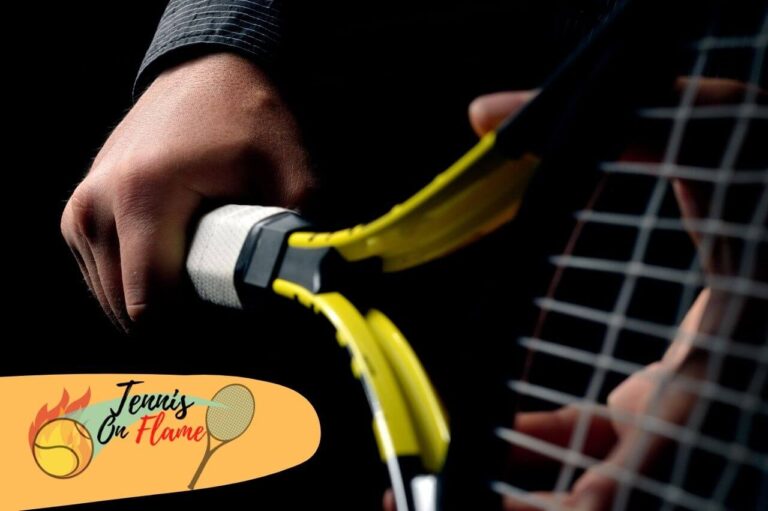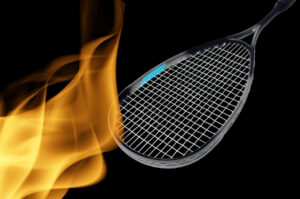This article is going to answer one of the most common questions: what is the difference between tennis racket grips?
Hey there, fellow tennis enthusiasts! I’m Matt, a die-hard fan of the game, and I’m about to embark on an exciting journey with you through the intricate world of tennis racket grips.
Have you ever wondered why some players seem to have a magical touch while others struggle with their shots? It all comes down to the grip, my friends!
So, buckle up your tennis shoes, grab your rackets, and dive into the fascinating universe of tennis grips.

Understanding the Basics
Tennis, like any other sport, demands a solid foundation.
The grip is your connection to the racket, influencing every shot you make. So, what’s the difference between tennis racket grips?
Continental Grip: The All-Purpose Foundation
The Continental Grip is the Swiss Army knife of tennis grips. It’s a versatile grip that serves as the foundation for many players.
Placing your base knuckle on the third angle of the racket, this grip allows you to switch between forehand and backhand shots easily.
It’s like the classic vanilla ice cream – a safe and dependable choice.
Eastern Grip: Precision and Control
Moving slightly from the Continental Grip, the Eastern Grip involves placing your base knuckle on the second angle.
This grip offers more topspin on your shots, allowing for better control and precision. Think of it as adding a sprinkle of finesse to your game – a touch of sophistication that sets you apart.
Venturing into Advanced Territory
Now that we’ve covered the basics let’s explore some advanced tennis racket grips that can elevate your game to new heights.
Western Grip: Dominating with Topspin
Welcome to the Western Grip, a favorite among baseline players.
With the base knuckle on the first level, this grip facilitates high topspin, making it ideal for heavy hitters.
It’s like adding a spin to your shots that can leave your opponents scratching their heads.
Semi-Western Grip: A Balanced Approach
The Semi-Western Grip is the answer for those seeking a middle ground between Eastern and Western grips.
Placing the base knuckle between the first and second angles, this grip offers a balanced blend of power, spin, and control. It’s the Goldilocks of tennis grips – just right for an all-around game.
Two-Handed Grips: Double the Power
Consider the two-handed grips if you’re a rebel looking to break the mold.
These grips provide additional stability and power, whether the classic two-handed backhand or the daring two-handed forehand.
It’s like wielding a lightsaber with both hands – a force to be reckoned with.
Finding Your Perfect Fit
Choosing the proper grip is a personal journey.
Let’s explore some factors that can help you discover your ideal tennis racket grip.
Hand Size Matters
Consider the size of your hand when selecting a grip size.
A grip that’s too small or too large can affect your control and comfort on the court.
Measure your hand and choose accordingly – it’s like finding the Cinderella slipper for your racket.
Playing Style and Preferences
Your playing style influences the grip that suits you best.
Aggressive baseliners might lean towards Western grips, while all-court players might find comfort in the versatility of the Eastern grip.
It’s about aligning your grip with your playing persona – like choosing the exemplary character in a video game.
Experiment and Adapt
Don’t be afraid to experiment with different grips during practice sessions.
Feel the nuances of each grip and observe how they impact your shots.
Adaptability is critical to evolving as a player – like upgrading your gear in a quest for the perfect loadout.
Mastering Transitions
Successfully transitioning between grips is an art that can make or break your game.
Let’s explore how to move from one grip to another seamlessly.
Smooth Forehand to Backhand Transitions
For those using a semi-Western or Eastern grip, transitioning from forehand to backhand requires a subtle adjustment.
Practice smoothly rotating your hand during rallies – it’s like a choreographed dance where every step is crucial.
Mastering the Serve
The serve is the opening act of every point, and the proper grip can make it a showstopper.
Experiment with your Continental grip for consistent first serves and transition to a more aggressive grip for those killer second serves. It’s like having a versatile toolkit for different scenarios.
| Grip Type | Advantages | Best Suited For |
|---|---|---|
| Continental Grip | Versatility | All-around players |
| Eastern Grip | Precision and Control | Players seeking finesse |
| Western Grip | Topspin Dominance | Baseline players |
| Semi-Western Grip | Balance of Power and Control | All-around players |
| Two-Handed Grips | Double the Power | Rebels and power hitters |
Wrapping it Up
Phew, we’ve covered quite a bit, haven’t we?
From the foundational grips to the advanced techniques, finding your perfect fit, and mastering transitions – you’re now armed with the knowledge to conquer the court.
In the grand symphony of tennis, your racket is your instrument, and the grip is the melody you create.
So, experiment, find your rhythm, and let the game unfold in the most harmonious way possible.








